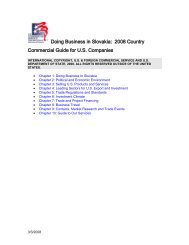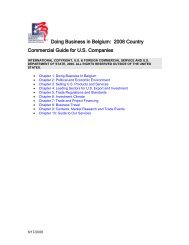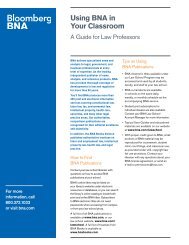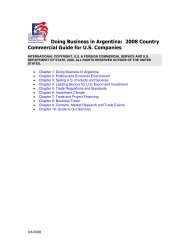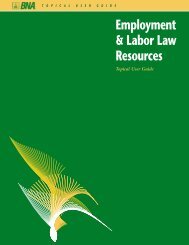Doing Business In (Insert Country Name Here) - BNA
Doing Business In (Insert Country Name Here) - BNA
Doing Business In (Insert Country Name Here) - BNA
Create successful ePaper yourself
Turn your PDF publications into a flip-book with our unique Google optimized e-Paper software.
Return to table of contents<br />
Chapter 5: Trade Regulations and Standards<br />
• Import Tariffs<br />
• Trade Barriers<br />
• Import Requirements and Documentation<br />
• U.S. Export Controls<br />
• Temporary Entry<br />
• Labeling and Marking Requirements<br />
• Prohibited and Restricted Imports<br />
• Customs Regulations and Contact <strong>In</strong>formation<br />
• Standards<br />
• Trade Agreements<br />
• Web Resources<br />
Import Tariffs Return to top<br />
Member states of the European Union have established a Community <strong>In</strong>tegrated Tariff<br />
(TARIC) system, where duties are applied to imports from non-EU countries. TARIC<br />
was established by the 1958 Treaty of Rome as part of the European Economic<br />
Community (EEC). The Uruguay Round has reinforced the Single Market program. It<br />
focuses on the consolidation of an integrated European market, rather than on<br />
developing new policy directions. There are combined bilateral, regional, and<br />
multilateral policies.<br />
Duties levied on imports from non-EU countries, including the United States, are<br />
moderate. Most raw materials enter duty-free or at low rates, most manufactured goods<br />
are subject to rates between 5 and 17 percent. Most agricultural product imports are<br />
covered by the Common Agricultural Policy (CAP), subjecting many items to varied<br />
levies designed to equalize the prices of imported commodities with those produced in<br />
the EU. Agricultural products are strictly regulated based on EU and French standards.<br />
France and other EU member states have a network of bilateral and regional trade<br />
agreements. The EU has entered into customs union agreements (with Turkey, Cyprus,<br />
Andorra and Malta) and 26 free trade agreements under either GATT Article XXIV or<br />
GATS Article V. There are free trade agreements (two-way free trade without common<br />
external tariffs) and other sorts of preferential trade agreements with Norway, Iceland,<br />
Switzerland, Liechtenstein, Israel, the Palestinian Authority, Tunisia, Morocco, Jordan,<br />
Egypt, Lebanon, Syria and Algeria. Free Trade Agreements with Mexico and South<br />
Africa were concluded in 1999. The EU provides non-reciprocal preferential access to<br />
its markets to ACP countries (African, Caribbean and Pacific developing countries)<br />
under the Cotonou Agreement, and to other developing countries under the Generalized<br />
System of Preferences (GSP).<br />
To export consumer-ready food products to France, a U.S. exporter should consider<br />
market access restrictions and food laws. Most processed products entering the<br />
European Union and France are subject to additional import charges based on the<br />
2/15/2008 <strong>Country</strong> Commercial Guide for France 71<br />
INTERNATIONAL COPYRIGHT, U.S. & FOREIGN COMMERCIAL SERVICE AND U.S. DEPARTMENT OF STATE,<br />
© 2007. ALL RIGHTS RESERVED OUTSIDE OF THE UNITED STATES.



